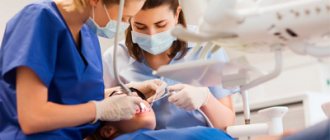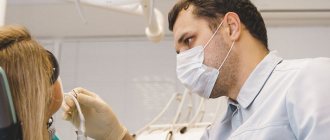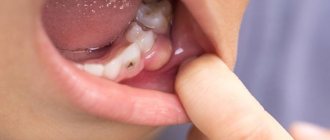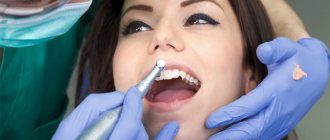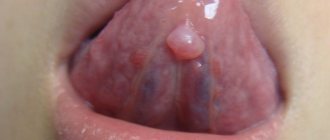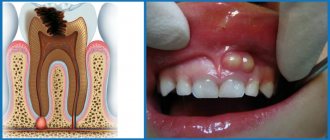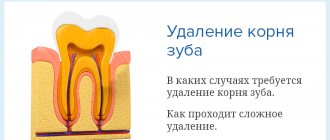What is a dental cyst?
Tooth cyst - what is it? An odontogenic cyst is a pathological neoplasm that occurs in the upper part of the tooth root. The internal cavity of the cyst is filled with liquid or mushy purulent contents; it is enveloped by a dense layer of epithelium.
The size of the cyst starts from a few millimeters, with rapid development reaching several centimeters in circumference. Most often, the pathological process affects the upper jaw, since the roots of its teeth have a more porous structure.
In order to understand what a dental cyst is and how to treat it, you need to know why such a phenomenon occurs. The formation of cysts occurs as a result of inflammation, thus the body restricts healthy tissue from the affected areas, clogging them along with bacteria into bubbles.
Causes
There are several reasons why a dental cyst develops. The main reason is the activity of pathogenic microorganisms in a closed dental space; the following risk factors contribute to this:
- severe pathology, lack of timely treatment and incorrect treatment of dental diseases - caries, periodontitis, pulpitis;
- infectious complications after tooth filling, implantation procedures - in such cases, the doctor removes not only the cyst, but also the crown or implant, this avoids relapse;
- complications during teething, especially when wisdom teeth erupt - dental tissues injure the gums, bacteria get into microcracks,
- microorganisms also enter wounds that form due to mechanical damage to teeth;
- Nasopharyngeal diseases – infections in the nose and throat can spread to the oral cavity.
To provide adequate treatment, it is necessary to accurately determine the cause of the development of a dental cyst; based on it, the dentist will prescribe suitable therapy. So, in cases of injury, treatment consists of removing the cyst and tissue regeneration, but if the cyst is a complication of another disease, then in addition to removing the vesicle, the patient will be prescribed treatment for the underlying disease.
Possible complications
Incorrect dosage, non-compliance with the rules for taking medications, as well as incorrectly selected medications can provoke the following unpleasant consequences:
- Alveolitis is an inflammation of the socket of an extracted tooth.
- Periodontitis is an inflammatory process that develops in the soft tissues surrounding the empty socket.
- Flux is inflammation of the periosteum.
- Osteomyelitis is purulent-necrotic processes affecting the jaw bone tissue.
So, in modern dental practice, after tooth extraction, if there are indications (inflammatory processes, certain chronic diseases, problems with blood clotting), it is customary to prescribe antibacterial therapy. Why are such drugs needed?
The main task of antibiotics is to fight pathogenic microflora: pathogens of inflammation, the cause of suppuration and a number of other postoperative complications. Whether it is necessary to take medications is decided in each specific case by the dentist, based on the characteristics of the individual patient’s body and the presence of concomitant dental (systemic) diseases.
Types of dental cysts
Tooth cysts have different classifications, each of which is formed according to certain characteristic parameters of the pathology.
According to the nature of the disease, they are distinguished:
- residual cysts – occur after tooth resection (removal) surgery; this is the most common type of cyst;
- retromolar – formed during severe eruption of wisdom teeth;
- radicular - cysts are located on or near the tooth root;
- follicular – at the heart of such cysts is the germ of a permanent tooth; follicular neoplasms arise as a result of poor quality care of baby teeth.
Classification of neoplasms according to their origin:
- odontogenic – arise as a result of the transition of the inflammatory process from other dental diseases;
- non-odontogenic - the causes of the development of such cysts include problems not related to the teeth and oral cavity.
Locations of cystic formation:
- anterior teeth;
- teeth that are adjacent to the nasal sinuses with their roots;
- wisdom teeth.
How to select medications
The answer to the question of whether you need to take antibiotics after tooth extraction has been received. Now it is necessary to find out what means should be taken in this or that case. The selection of a drug for a child or adult patient is carried out based on the general condition of the patient’s body, the presence (absence) of an allergic reaction to certain medications, the localization and degree of the inflammatory process.
Antibiotics after tooth extraction must meet the following requirements:
- medicinal components must penetrate well not only into the gum tissue, but also into the bone tissue;
- ensuring a cumulative effect for prolonged action of the drug;
- maintain the required concentration for at least 8 hours so that the patient can conveniently take medications (not “get out of line” with the therapy regimen);
- Aerobic and anaerobic microflora must be susceptible to the antibiotic;
- minimum side effects, minor toxic effects on the body;
- the product must be suitable for outpatient treatment.
Inflammatory processes, bacterial infections, and other associated dental problems are the main indications for antibiotic therapy after tooth extraction
Symptoms
The danger of a dental cyst lies in the fact that signs of pathology appear only when the neoplasm reaches a relatively large size. In the early stages, small cysts do not manifest themselves in any way, meanwhile the infectious process covers an increasingly larger area of healthy tissue. In the initial development of pathology, cysts are discovered by chance during routine examinations or treatment of other diseases.
The duration of the formation of a dental cyst takes only 1-2 days; as it develops, the following symptoms may occur:
- unpleasant and even painful sensations in the tooth, which intensify when chewing solid food;
- protrusion of the gum of a tooth, in the area of the root of which a cyst forms, the growth of the gum becomes larger over time, redness is observed;
- the formation of a fistula in the area above the root of the tooth, the release of serous or purulent accumulations from it;
- general weakness and malaise;
- increase in body temperature.
Note! When a dental cyst occurs, the symptoms are not immediately visible; they appear in the later stages of development. The pain when a tumor appears is aching in nature, but it is less pronounced than the pain caused by caries and pulpitis.
If a clinical picture occurs and you suspect a pathological process, be sure to consult a doctor. Under no circumstances should you resort to self-treatment - the dental cyst must be removed. In addition, taking the wrong medications can worsen the patient’s overall well-being.
Sometimes there is no pain in the oral cavity; instead, the basis of the clinical picture is intense headaches. The cause of this phenomenon may be a cystic formation in the maxillary sinus.
Removal of a wisdom tooth on the lower jaw
Most people of conscious age go to the dentist because of problems with their lower wisdom teeth.
They often interfere, put pressure on neighboring molars, and cause discomfort or pain after eating. Most often, wisdom teeth in the lower jaw appear between the ages of 20 and 25, although the timing varies from person to person; for some, they may appear at the age of 16, for others closer to 40 years. In most cases, the appearance of figure eights is accompanied by various complications that require their removal. Malocclusion, difficulty in teething, tumors and trauma to the mucous membrane and much more.
Consequences
Without adequate treatment, the dental cyst continues to grow and develop; in advanced stages, large neoplasms destroy the bone tissue of the skull, as a result it is replaced by connective tissue formations, which leads to the development of the following complications:
- dissolution of the jaw bone, which depends on the growth of the cyst;
- the formation of pus in the cyst, further purulent inflammation can lead to the development of an abscess;
- inflammatory process of lymph nodes located near the source of infection;
- development of osteomyelitis or periostitis;
- development of chronic sinusitis when the cyst grows in the maxillary sinus;
- pathological fracture of the jaw bones when the cyst reaches a large size;
- development of phlegmon due to a long-term purulent inflammatory process in the cyst;
- sepsis – blood poisoning;
- degeneration of a cyst into a malignant tumor without timely treatment.
Many patients are interested in why a dental cyst appears in the maxillary sinus, how dangerous it is and its symptoms. The formation of a cyst of this type occurs as a result of untreated inflammation of the tooth root in the upper jaw. A granuloma forms at the root of the tooth, which increases in size and becomes a peri-radicular cyst, then takes a position in the maxillary sinus. The volume of such a cyst can reach 9-12 cubic centimeters.
The symptomatic picture includes painful sensations, the nature of which is similar to trigeminal neuralgia, pain in the occipital, temporal and parietal regions of the head. Externally, a dental cyst can be identified by the asymmetry of the face. Tooth cyst - photo shows a cyst in the maxillary sinus.
Diagnosis of tooth root cyst
To make a diagnosis and carry out appropriate treatment, the dentist collects and analyzes the medical history. During the initial diagnosis, many patients report the fact of endodontic treatment performed to eliminate periodontitis or pulpitis. Some patients indicate an exacerbation of the disease after intraoral dissection.
Radiography is used as the main diagnostic method. Below is a photo and x-ray of a dental cyst.
To obtain an x-ray, several methods are used, the first method is based on contact intraoral x-ray, the advantages of this technique:
- determining the degree of destruction of the jaw bones;
- assessment of the condition of the tooth root and tooth canal;
- assessment of the quality of canal filling;
- identifying the presence of perforations and fragments of instruments and materials in the tooth canal;
- determination of the relationship between the cyst and the roots located near the teeth.
The second method of performing radiography is an orthopantogram; the procedure is a panoramic photograph of both jaws and the maxillary sinuses of the upper jaw.
Another method of the procedure is a survey X-ray in the nasomental projection; the X-ray covers the bones of the skull from the nose to the chin; using the image, the doctor assesses the condition of the maxillary sinuses and detects cysts that have grown into the nasal cavity.
In addition to radiography, to detect a tumor, the patient may be prescribed an electroodontic diagnostic procedure. This technique helps to assess the degree of such an indicator as the electrical excitability of the teeth that are located next to the cystic tooth. If the value exceeds 60 microamps, the dentist prescribes endodontic treatment to the patient.
For diagnostic purposes, histological and cytological studies are used to determine whether the neoplasm is benign or malignant.
Diagnosing a dental cyst is not difficult, but only qualified dentists can carry it out in a hospital setting; under no circumstances try to independently determine the presence of a cyst and do not take therapeutic measures; strictly follow the doctor’s recommendations.
When is it necessary to remove the lower wisdom tooth?
Eighth teeth are removed in two cases: when they have not yet sprouted or are already protruding from the gums. In the first case, the operation is performed if the patient feels discomfort, and during an external examination the doctor does not see diseased teeth. The appearance of pain means that the molar in the gum is pressing on its neighbor and disturbing him.
If the wisdom tooth has erupted incorrectly - that is, not straight up, but with a deviation, at an angle to the jaw and neighboring teeth, then removal is also a mandatory procedure. The slope of the figure eight is:
- distal - when the “eight” is tilted back, away from the “seven”. In this case, there is a risk of injury to the gums and damage to the roots of the adjacent tooth;
- medial - when the “eight”, on the contrary, is inclined towards the neighboring tooth. This increases the likelihood of damage to the crown part of the “seven” and the development of caries on both teeth;
- buccal – in this case, the wisdom tooth is turned towards the cheek and constantly touches the mucous membrane, causing irritation and hardening of the tissues. This condition can eventually lead to the formation of a tumor on the mucosa.
The removal of a wisdom tooth in the lower jaw is definitely necessary in the following cases:
- Caries on a wisdom tooth.
- Lack of space in the row for teeth. The last molars put pressure and cause discomfort.
- Pain in the gum where the wisdom tooth is located, at any time of the day, even after sleep.
- Incorrect growth sideways towards the tongue or larynx. This phenomenon is called dystopia.
- It interferes with implantation.
A tooth can erupt without causing pain once it appears; it will still be removed because it is not growing properly. The dentist makes an accurate diagnosis. To make an appointment, leave a request on the website or call one of the numbers: +7-924-444-05-45 - administrator
Removing a wisdom tooth in the lower jaw is a more complex procedure than removing an upper tooth. The bottom eights have a more powerful root system, and the jaw bones are denser and thicker. To remove a lower molar, it is necessary to perform a complex operation with dissection of the gum. In some cases, the surgeon has to remove part of the bone, divide the root into several parts and extract them separately.
Sign up for a free consultation
Treatment
Treatment of dental cysts is carried out through surgery, laser treatment and conservative therapy. The latter has a positive effect only in the initial stages of the disease; overgrown cysts must be removed.
Surgery
To eliminate the pathology, it is not necessary to remove the entire tooth; only the tooth root on which the cyst is located is subject to resection. After removing the affected area, the dentist seals the remaining root, treats the surgical canal through which he removed the bladder with its contents, and stitches it up.
After a few days, the doctor removes the stitches and monitors the wound healing process. It is important to make sure that there are no cyst particles left in the dental canal; to achieve this goal, repeat radiography is performed.
Note! Sometimes it is impossible to remove the root along with the cyst; in these cases, the doctor completely removes the tooth. Indications for complete tooth resection are a difficult-to-reach location of the cyst and a severe course of the disease.
After surgical removal of a cyst, the patient must regularly visit the dentist and follow the recommendations prescribed by the doctor.
Conservative therapy
Tooth cyst - treatment of the disease with conservative methods is possible only in the early stages of its development. In order to eliminate the tumor, the patient is prescribed injections and rinses.
During therapeutic treatment, the dentist opens the dental canal, which leads to a cystic neoplasm, and pumps out exudate from it. The doctor does not fill the canal for ten days; during this period, the patient uses antiseptic solutions and tinctures to rinse the mouth.
Upon completion of the treatment course, the dentist treats the dental canal with medications and then fills the tooth.
Laser removal
Laser treatment is a modern method of treating dental cysts. When performing the method, the doctor opens the dental canal and uses laser irradiation to treat the area where the cystic tumor is located. The laser destroys not only the epithelium of the cyst, but also hundreds of thousands of bacteria that are inside the bladder.
The advantages of laser removal are rapid tissue healing and no risk of secondary infection in the oral cavity and dental canal.
Treatment with antibiotics
In some cases, dental cysts are treated with antibiotics. Taking antibacterial drugs is an auxiliary measure to destroy an expanded infection or the main method of treatment if a dental cyst develops against the background of a primary infectious disease.
Antibacterial drugs can only be prescribed by the attending physician; the following drugs are most often used:
- amoxicillin – has a high antibacterial effect, greatly facilitates the treatment of cysts with other methods;
- Cifroploxacin is a broad-spectrum antibiotic that actively destroys bacteria and relieves inflammation;
- tetracycline - this drug is prescribed more often than others, it actively relieves the inflammatory process, pain syndrome, and facilitates other methods of treating dental cysts.
Sometimes a doctor can prescribe topical antibacterial agents to a patient, but taking such medications is not always advisable - local drugs - antibiotics are quite difficult to distribute evenly over the diseased area.
Note! Antibacterial drugs are potent drugs that also affect beneficial bacteria in the body. You can take such medications only as prescribed by a doctor, without increasing the number of doses or dosage.
Treatment at home
Treatment of dental cysts at home is possible only as an auxiliary therapy. A cyst should not be confused with a granuloma; the latter can resolve on its own, but the cystic formation must be radically removed. Home treatment is not used to remove the cyst, but to eliminate the inflammatory process and destroy harmful bacteria.
The main goal of therapy at home is to provide an antiseptic effect. Propolis tincture, calendula tincture, eucalyptus tincture have an antiseptic effect. Tinctures are used as follows: a small amount of medicine is applied to a cotton swab and applied to the affected area, held for 5-10 minutes.
Medicines with an antiseptic effect can be used before surgery to remove a cyst and after tooth root removal. The antiseptic effect allows these medications to be used in the treatment of caries and other infectious diseases of the oral cavity.
Prevention
It is always easier and faster to prevent any disease than to cure it, so one should not forget about simple preventive rules that will help avoid the development of a dental cyst. The basic rules for preventing dental cysts are based on compliance with the rules of oral care.
How to prevent the formation of pathology:
- do not trigger the course of dental diseases such as caries, periodontitis, pulpitis; if infections occur, consult a doctor immediately;
- Brush your teeth daily and prevent the appearance of plaque, which can later transform into tartar;
- monitor the condition of the teeth and oral cavity after operations and mechanical injuries;
- visit your dentist regularly;
- monitor the condition of filled teeth and dental implants;
Patients who have had their teeth filled or have dental crowns or implants placed are advised to periodically have dental x-rays taken. This will allow timely detection of pathological changes and increase the chances of successful recovery without serious consequences.
Note! All diseases must be treated in a timely manner; inflammatory processes reduce immunity, as a result of which infections move freely from one organ to another; in addition, secondary infections can be added to already developed pathologies. It is important to monitor your health and strengthen local and general immunity.
To strengthen your immune system, strengthen your body, include fresh fruits and vegetables in your diet, play sports and walk outdoors more often. It is more difficult for any infection to get into a hardened body than into a weakened body.
Main activities after extraction
As soon as the tooth is removed, the doctor treats the empty socket and places a cotton swab soaked in the medicinal composition into it. In some cases, stitches may be required. On the recommendation of the dentist, the tampon is removed several hours after the manipulations.
During this time period, it is forbidden to eat, smoke, drink, talk, that is, it is better not to open your mouth at all. You should also not touch the hole with your fingers or insert foreign objects into it. To disinfect (disinfect) the oral cavity, you should use Furacilin, Miramistin, Chlorhexidine, Chlorophyllipt.
Important! To prevent postoperative bleeding, you should not bend over, lift heavy objects, visit saunas, or take hot baths.
Upon completion of the extraction, patients can be prescribed antibacterial compounds in various dosage forms - tablets, capsules, drops, local solutions and applications
